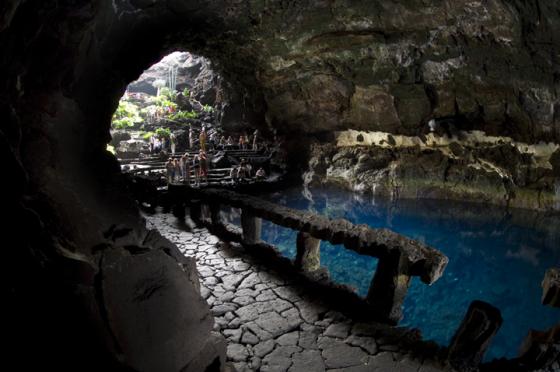
Dive Into the Lava Dome

I recently participated in an expedition to Atlantida Cave in Lanzarote. That gave me the dubious honor of having explored caves created in the coldest and hottest conditions on our planet. It was also a part of my plan to spend part of my winter in the tropics rather than the Siberian outback.
Just 60 miles from the North African coastline, the beautifully peaceful island of Lanzarote hides its volatile past. Along this island arc are dynamic features that have revealed the earth's innermost geologic secrets for perhaps millions of years. Sudden, violent eruptions have formed virgin islands overnight.
The cave system associated with Atlantida Tunnel formed a mere three to four thousand years ago during the great eruptions of the Corona Volcano. A massive explosion carpeted lava down the slopes of the mountain. As the surface of the lava cooled and solidified, a thundering torrent of molten magma continued to pour through the core of the flow - a virtual subterranean fire hose of lava.
Meeting the ocean, a massive explosion vaporized seawater in its path as the hot tributary plunged below the surface. The final result was a tunnel almost four miles long that extends from the base of the volcano, down the side of the island to the coastline, before continuing an additional mile under the sea floor. From its vast size, unparalleled grandeur and enduring mysteries, it is easy to see why this final submarine section of the lava tube became known as the tunnel to Atlantis.
Several collapses on the lower slopes of the Monte Corona volcano provide entrances to the cave system - including a mile of passage opened as two separate tourist destinations. We accessed many other wild portions of the cave with basic dry caving and sump diving techniques.
Diving in Atlantida Tunnel is only possible through rare scientific permits, but it is not because of the challenges of entry. In fact, after walking through a show cave complete with a swimming pool, restaurants and concert hall, we arrive at our dive site. Carrying our gear, we parade past tourists standing at the bar, weave between diners and sightseers and climb over a railing in the restaurant to get to the water.
The walls of the entry pool to Atlantida are covered with exotic and colorful algae that are fed by the mix of artificial lights and the fluctuating tidal flows in the cave. Festive bands of gold, green and cyan algae are brightly contrasted with stark maroon and black lava rock beneath. Once submerged, one is struck by the sheer size of the cave passage often soaring to over 50 feet in height. The gin clear water offers visibility far in excess of 200 feet.
Accustomed to diving in limestone caves formed over hundreds of thousands of years, I was now diving in a cave that was formed in an instant! The contrast is sobering. Dripping formations were born from molten rock. Scours from rapidly flowing lava etched the walls in distinct layers. In places, undulating lava waves peeled off the wall, frozen in time.
The highlight of our expedition came with the successful collection of several remipede specimens that appear to represent an entirely undocumented species.
Despite the success of the expedition's efforts to collect keystone animals, many questions remain. Where do these stygobitic animals come from? Do they live in deep ocean habitats or in tiny spaces within the matrix of mid ocean ridges and seamounts? Did they simply ride around the globe on ancient drifting continental rafts? Is their rarity an indication of changing water conditions or a testament to perfection in evolutionary form?
Stygobitic cave animals have a unique survival strategy. Living in subaquatic darkness, these creatures developed improved senses of smell, taste and vibration detection. Eyes and pigment, and other unused anatomical features gradually disappeared. These animals are often endemic to a single, remote site, adapting to its particular environment and very scarce food sources.
Dr. Iliffe sums it up best. "Many of these animals are basically missing links in helping us to understand the origins of life in the oceans and generally the origins of life on Earth. They are totally new forms of life than is already known from anywhere else on the planet. The animals here provide us with a glimpse of what the Earth was like many, many millions of years ago."
Written by Jill Heinerth, Florida.